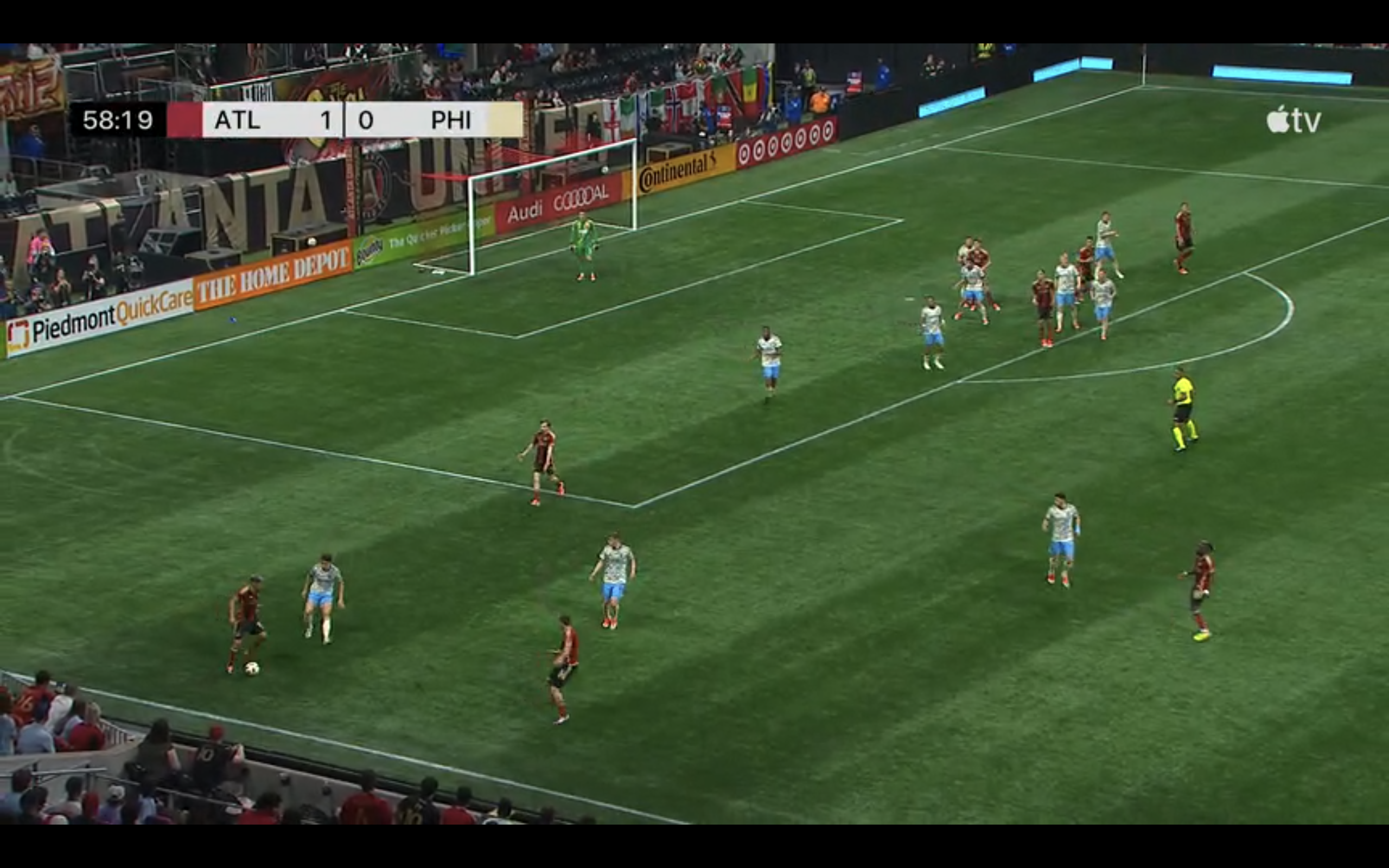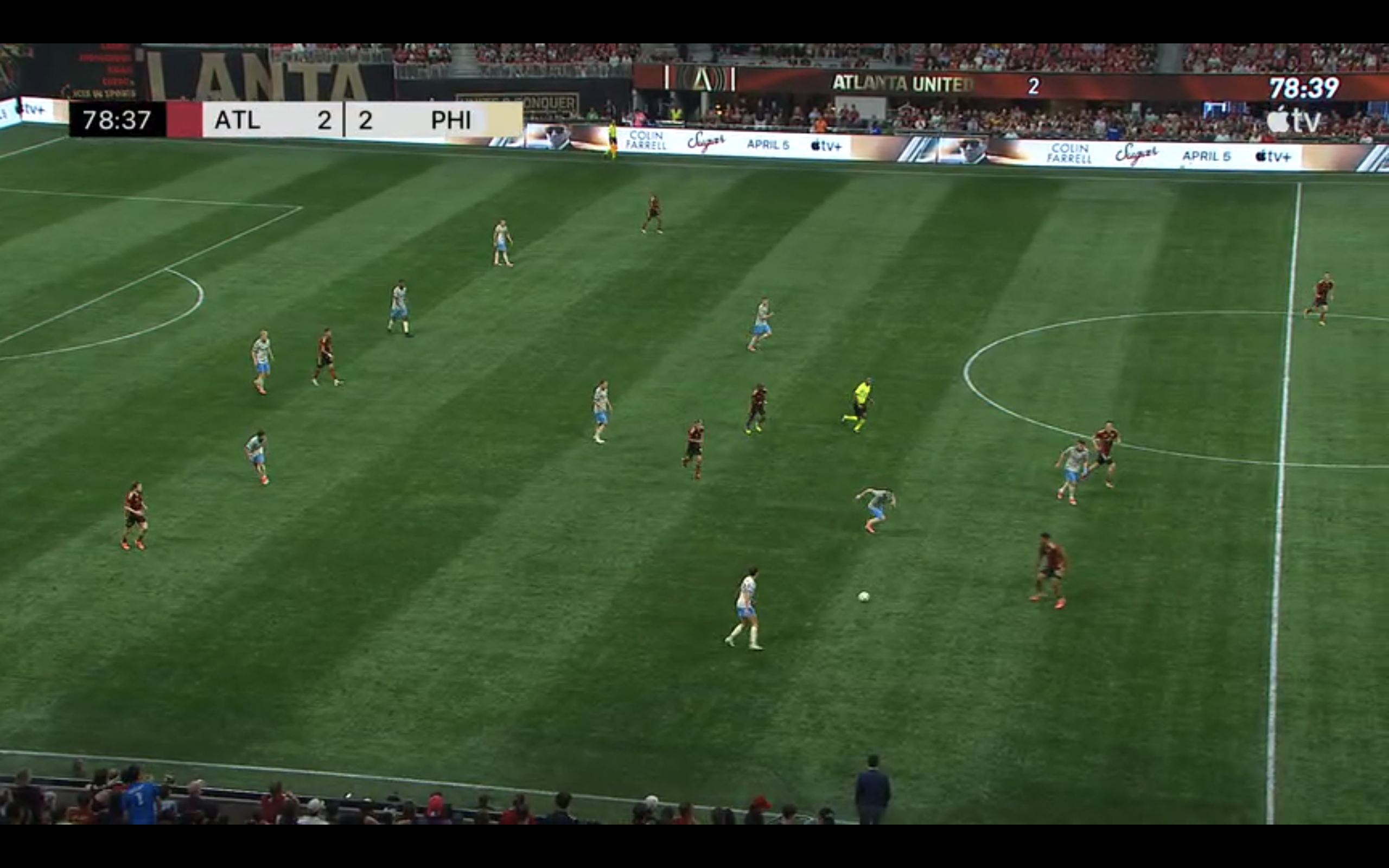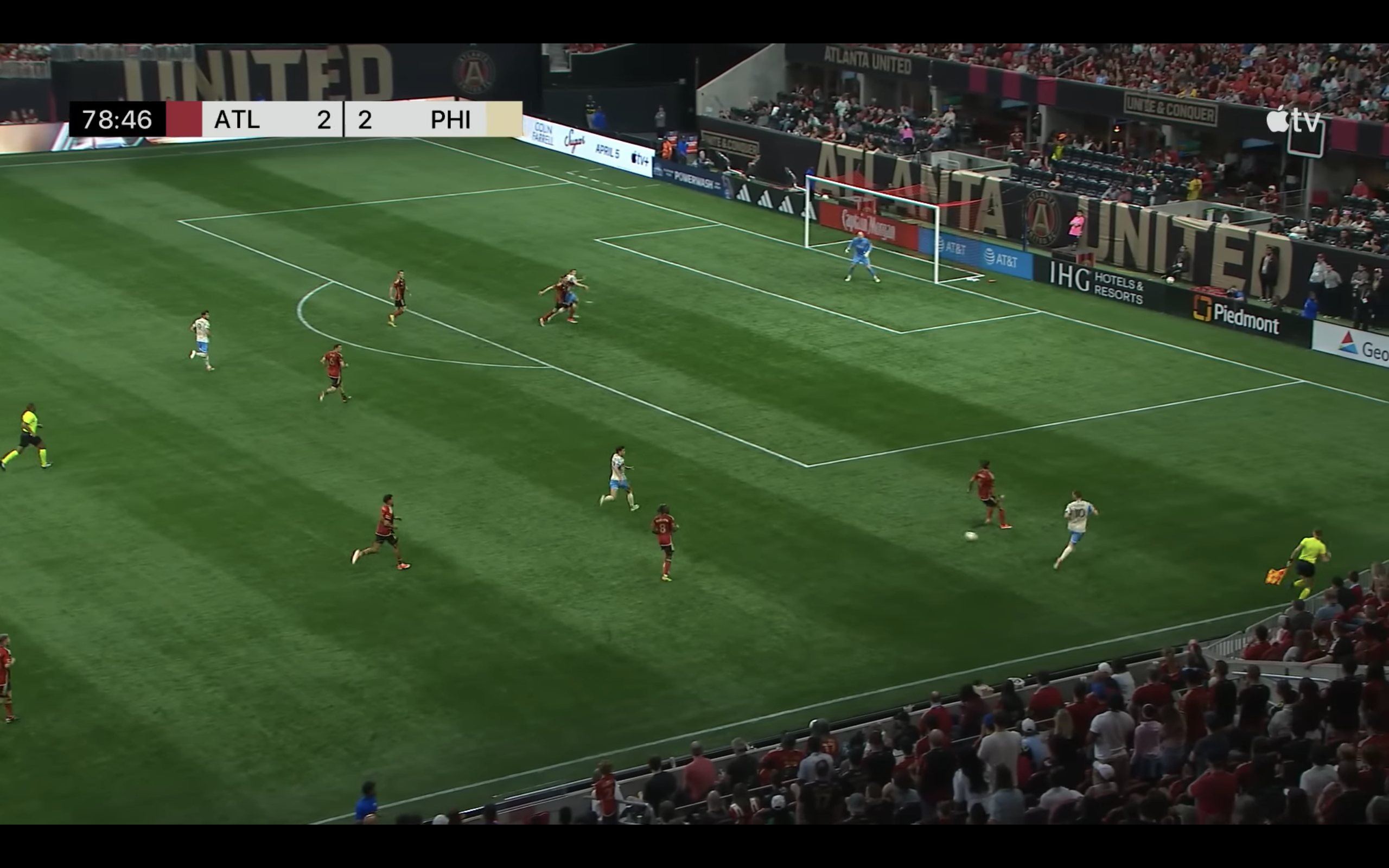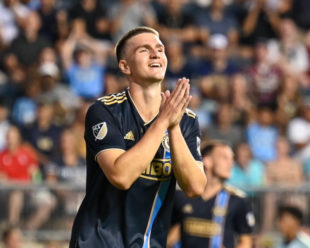Photo: Marjorie Elzey
The Philadelphia Union were opportunistic on Sunday, coming back from a two-goal deficit to steal a result on the road in Atlanta. If it weren’t for two Atlanta United defensive lapses, the Union could have easily been sent back to Chester with nothing to show for it.
Jim’s tactical je ne sais quoi
After having a good run of play over the last few matches, Jim Curtin decided to give Jack Elliott a rest on Sunday.
“It’s one of the few times in my coaching career where I don’t really have an answer as to why [Elliott] was the one to get a rest,” said Curtin when asked about it. “The one thing is maybe in a game against Atlanta where it turns into a track meet a bit, Damion’s ability to put out some fires and win those kind of crazy duels was something that we decided on… I want these guys all on their toes, all ready when they’re called upon.”
Though Curtin played down his decision to start Damion Lowe, it proved to be the right move. Lowe had a solid outing, jumping on top of every Atlanta break in the first half. He snuffed out multiple chances with superior anticipation, his willingness to throw his body in front of shots, and his twitchy athleticism.
(Video credit to Todd Lewis of the Free kick podcast)
It was an unfortunate turn of events when a Lowe clearance landed at the foot of Caleb Wiley, leading to Atlanta’s second goal. Other than that, Lowe’s trademark pace and anticipation were on full display in a tough environment on the road as he kept things mostly clean for his backup keeper, Semmle.
Set-piece success
Set-pieces continue to be a situational boon for the Union. Carranza came very close to scoring off of a corner early in the second half, but Brad Guzan was there to make the save.
However, it was a different kind of set-piece that led to the Union’s game-tying goal.
The Union may owe their success on throw-ins to an expert of sorts. Thomas Gronnemark, a renowned throw-in coach and consultant, made three visits to Philadelphia during the 2022 season. Gronnemark previously owned the Guinness world record for the longest recorded throw-in (yes, that is a thing) and has worked with clubs like Liverpool, Ajax, Toulouse, Brentford, Pachuca, and Midtjylland.
In an interview with the “Free Kick podcast” with Todd Lewis at this year’s coaches’ convention, Gronnemark spoke specifically regarding his work with Nate Harriel – improving his throw-in distance by over 7 meters.
The Union have now scored six goals on set-pieces, while only conceding one through seven MLS games on the year. Threats from dead-ball situations will be key to their success down the stretch as the season wears on.
ATL’s left vs. Philly’s right
For the first 60 minutes, Atlanta succeeded in suppressing the Union’s tendency for attacking down the right-side.
This was especially apparent early in the second half. Saba Lobzhanidze was given more freedom to roam from his right midfield position in the 4-2-3-1, creating overloads with Caleb Wiley, Tyler Wolff, Tristan Muyumba, and Thiago Almada down the left-hand side.
These actions hemmed Nathan Harriel and Alejandro Bedoya in on the right hand side, not giving them any opportunity to get forward. With how “right-side dominant” the Union attack is, and has been, this forced the Union into some really uncomfortable situations.

(Saba checks into space down the left, creating an overload)
In the second half, Wiley really began to come into the game. The nineteen year-old left back began to press up high, sustaining pressure and keeping Harriel’s positioning honest, forcing Harriel to contain Atlanta’s sustained attack down his side.
It wasn’t until the 66th minute, when Mikael Uhre was brought on in place of Martinez, allowing Sullivan to move back to his right shuttler role, that the Union were able to break through consistently down the right side. Sullivan’s ability to receive the ball under pressure finally gave the Union the outlet it needed to force Atlanta’s left side to retreat.
This afforded the Philly some room to breathe.
Yet, it took Carranza dropping deep on the right-side to pick up possession to create the first Union goal. Carranza’s astute movement and pressing after losing possession forced Atlanta’s Mosquera to play an errant pass that landed at the feet of Uhre, who did well to finish his chance.
With Sullivan’s improved play in possession on the right, Carranza and Gazdag felt invited to begin sliding out into the right channel, allowing Philly to hit with numbers in transition. This can be seen on the build up leading to Uhre’s would-be second goal, which was ultimately called back for offside.

(The Union break out on the right side with Sullivan, Gazdag, and Carranza leading the charge)
Uhre offside by two-and-a-half small men
Above all, a tie was a very good result for the Union.
That being said…
The refereeing was not the deciding factor in this game.
Whichever way you want to look at the call made on Uhre’s goal that was called back for offside, it is wrong to blame the referee or the assistant referee for making the call they did. The AR will always have the best angle, and Kathryn Nesbitt was seemingly right to raise her flag:
The disallowed goal for @PhilaUnion against @ATLUTD I have as being offside by 9 inches. Best model of the three, everything lining up a lot nicer here, so I feel pretty confident about this one. pic.twitter.com/OtgwG6O3GN
— SoccerPhotogrammetry AKA “A Nice Gentleman” (@OffsideModeling) April 15, 2024
The only real argument, as Jim Curtin suggested in his post-game press conference, is that the league should have the necessary camera angles to get the call right.
But, unfortunately, they do not.
Given those limitations, let’s not focus on the decision. The referee didn’t decide the Union’s fate–there were things that the Union, and specifically Mikael Uhre, could have controlled on this play.
Gazdag received the pass from Carranza on the break down the right and progresses, while Mikael Uhre expected him to rip a low cross in. Consequently, Uhre believed it best to try and beat his man to the near-post before Gazdag even showed any signs of making a cross.

(Uhre attempts to beat his man to the near-post before recognition of what Gazdag is trying to do).
By the time Uhre realized that the cross wasn’t coming, he was in too deep – too close to the Atlanta goal. He quickly tried to get himself onside by moving backwards toward the penalty spot. The only problem being that the ATL backline was actively trying to catch him offside, so they were smart enough to move up as a unit as the ball was played back to Sullivan at the top of the box.
What Uhre could have done that would have served him and his team better, is to move laterally toward Sullivan instead of standing stagnantly waiting for Sullivan to pass. Had he moved laterally, even just a slight jog to keep his feet moving, he:
- wouldn’t be leaning toward the goal, making his frame narrower, allowing less of him to be in an offside position,
- would be in an athletic position to receive the ball, turn, and shoot,
- or could have opened up the backdoor pass from Sullivan to Carranza

(Sullivan weighs his options before passing to an offside Mikael Uhre)
Uhre has a known penchant for being offside.
In fact, Mikael Uhre is tied for second in MLS with 8 offside calls against him. His 1.95 offiside calls against him per 90 minutes are far and away in the lead for players who have played at least 250 minutes.
He shares this attribute with some of the best strikers to play the game – Ruud van Nistelrooy immediately comes to mind. The Manchester United and Real Madrid legend often used offside positioning to make defenders forget about him, until he would pop up out of nowhere at the last second to tap in an easy chance.
You may call that cherry-picking, but I call that poaching. The major difference, is that van Nistelrooy used the second to last defender to his advantage. Mikael Uhre hasn’t quite figured that skill out yet.
To be clear, Mikael Uhre isn’t Ruud van Nistelrooy, nor is he trying to be.
Uhre does some things really well. He is pacey, he plays in a direct fashion which fits the Union style, he can be uber-efficient in front of goal.
But what Uhre doesn’t do well is play off another striker, nor does move well laterally, nor does he poach goals consistently like van Nistelrooy did.
And that is fine. Uhre can find success without doing some of those things. Yet it is undeniable that he is at his best when he is doing all of those things. The goal that Uhre did score will go a long way for his confidence. He needs it, as the best Union eleven features a confident Mikael Uhre playing off of a just as confident Julian Carranza.


Well done, Blake. I did not realize that the Union had brought in a coach for throw-ins. Harriel’s 7 meter improvement in throw-ins is remarkable (He does need to watch his foot positioning, though, lest he be called for a foul throw–it looked mighty close.).
That was a very passionate tactical analysis of the offside trap. Kudos to the AR getting it right…….thanks
Clever section title playing off the press conference comments (“Uhre offside by two-and-a-half small men”). Bravo.
Excellent analysis. I have been down on Uhre for the past two years especially with his constant offsides and poor finishing. Thank you for covering the offsides issue.
I think Lowe is getting more credit than he deserves for this performance. Yes he did some nice things but he was also directly involved in both Atlanta goals.
You mentioned his clearance falling straight to Wiley, which is unfortunate to be sure. What stood out more to me, however, was his role in the Rios goal.
If you pause right at 54:43, or right when Almada is playing the cross, you can see that Lowe is behind the Union defensive line and is the only one keeping Rios onside. Lowe has a tendency to “play center field” i.e. drop behind the line when he finds himself defending in an uncomfortable position in order to keep the play in front of him. We’ve seen this habit pop up plenty of times in the past, most notably against Miami in the Leagues Cup last season. It popped up again in an untimely spot here.
Lowe is a very good individual defender who made some nice individual plays against Atlanta, but his inability to stay connected to the team’s defensive line at times has cost the Union points on multiple occasions.
That’s an interesting observation, I think you’re definitely right in that he’s keeping Rios onside there. I do think to say he played a part in that goal is correct, but I also think it’s harsh, and somewhat deflecting the role of Glesnes/Semmle had on the play.
–
In my estimation, glesnes needs to recognize and communicate to Lowe there. Glesnes has a better angle to see the positioning of Lowe on that play. Not to mention that glesnes isn’t goal-side of his own man there. I understand they may be trying to trap Rios, but if Glesnes is goal-side of his mark from the get-go, Rios has a much harder time getting his head on it.
–
All that to say, that ball landed inside the 6, and to me, Semmle needs to claim that or punch it away.
Ok so I’m late to the party here but fashionable as is my custom. I can’t help but look at the offside rendering and wonder why isn’t the shoulder of the Atlanta player being used? It certainly looks like the shoulder of that defender would keep Uhre onside. I’m not complaining about the call. Just a question that came to me looking at the lines. I think it sticks out to me that the line goes right through the defenders body. I’m not sure how the rule reads on this. Is the foot the only body part to be used? If so then why not Uhres foot?
I don’t know the ins and outs of how that line was generated. It is a Twitter account that applies the lines to an estimated scale since the camera angle is off. That may be why you would see the line drawn appearing to go through the body of the Atlanta defender, it’s simply perspective, and I can’t speak to the correctness of the line. But Uhre does appear offside based on this rendering.
–
As far as the offside rule is concerned, it’s based on parts of the body that can play the ball. So basically, if any part of the body, except for the arm and hand, is beyond the last defender’s parts of the body that can play the ball, it is offside. Shoulder counts as a part of the body that can play the ball.
Thanks for that detail, Blake!